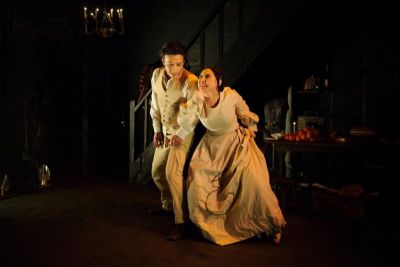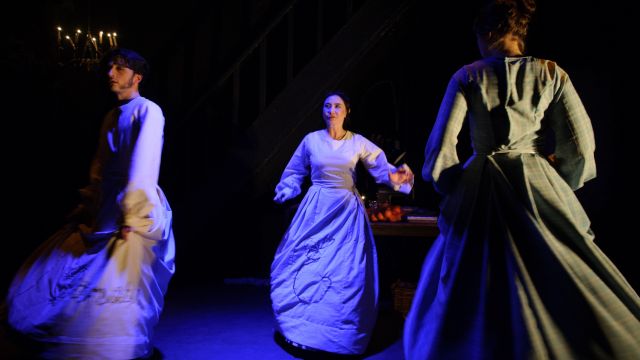Miss W Treads
Eliza Winstanley was a Sydney actress and star of the Australian theatre in the 1830s who later went on to ‘tread the boards’ in the UK and the USA, and became a writer, editor and novelist. Jane Woollard’s play about her life, Miss W Treads, employs the framing device of a playwright, Imogene (Ruby Johnson), researching and struggling to write a play about Winstanley’s life. Although seemingly blocked, Imogene feels such an intense connection – or identification - with her subject that Winstanley (Fanny Hanusin) – and her Irish husband, Henry O’Flaherty (Nicholas Kato) – appear and speak to her. Imogene makes and wears a facsimile of one of Winstanley’s dresses. She ‘casts’, as it were, Tarquin (also Mr Kato), her musician collaborator on her play, as O’Flaherty.
The question we might ask, however, is ‘And the point is…?’ The careers of Miss W and her husband may be of academic interest to students of, say, colonial theatre, the success of a woman in this context, and the conventions of 19th century theatre, including stock gestures to convey emotion and so-called ‘pants’ roles – i.e. actresses in trousers. But can that interest generate a theatrical drama?
It emerges that, in fact, we know little about Miss W/Mrs O’Flaherty beyond her achievements – which were considerable, given her time and gender. Our fictional playwright Imogene almost wants to be Miss W, but struggles to give form to her celebratory play because – I’d suggest – there is no inherent or discovered contemporary dramatic reason to tell this story beyond ‘woman achiever’ or ‘interesting’.
 Unfortunately, Jane Woollard appears to have the same problem. Her play feels fragmentary and directionless even while roughly following Winstanley’s life – and this despite the dramaturgy of the accomplished Melanie Beddie. The play appears to end with Imogene pretty much defeated by the enigma of Miss W, wondering if her connection to her has been nothing but her own imagination.
Unfortunately, Jane Woollard appears to have the same problem. Her play feels fragmentary and directionless even while roughly following Winstanley’s life – and this despite the dramaturgy of the accomplished Melanie Beddie. The play appears to end with Imogene pretty much defeated by the enigma of Miss W, wondering if her connection to her has been nothing but her own imagination.
Mysteriously, Ms Woollard casts award-winning Fanny Hanusin as this star of the Sydney and later London and USA theatre. For all her gifts (and her hard work) Ms Hanusin is simply wrong for this role, seriously stretching credibility that her Miss W is a theatre star during an extremely conservative era. Meanwhile, Ruby Johnson is so tentative – to the point of recessive – that we are never swept up in her dedication to and enthusiasm for her project – the very things the play needs to make it in some way viable. Mr Kato stands out here; he brings vitality and presence to his two roles, making them both characters (some sexy humour helps). He distinguishes between to the two with great clarity, including mastery of the Irish accent as O’Flaherty. Peter Farnan’s music, incidentally, is lovely and comes close to providing the emotions that aren’t coming from the stage.
It’s interesting to compare Miss W with Merrilee Moss’ 2016 play, Oriel, about another ‘forgotten’ theatre maker, Oriel Gray. Ms Moss cleverly writes herself in as the floundering contemporary figure in dialogue across the years with Oriel – from the start. There is a clear through-line and the fictional Merrilee contrasts ironically and humorously with her subject. Admittedly, Ms Moss had more access to her subject’s life than Ms Woollard has had to hers, but Oriel nevertheless comes to shine and to be admired by Merrilee and by the audience.
Clearly, Miss W Treads is a serious work, based on ‘long investigation’ (according to Ms Woollard’s program note), intended to bring to our attention someone of whom we had most likely never heard – but the play sadly doesn’t communicate Ms Woollard’s powerful interest in her subject. We need to care for our reasons.
Michael Brindley
Photographer: Sarah Walker.
Subscribe to our E-Newsletter, buy our latest print edition or find a Performing Arts book at Book Nook.

